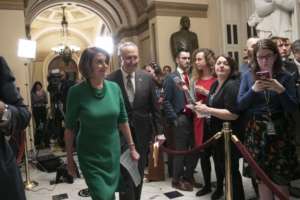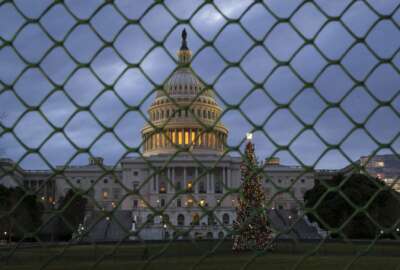
Partial shutdown could cost the government $52M a day
The suddenness of the partial government shutdown forced agencies and contractors to scramble over the last week to figure out who is working and who isn’t.
It looks as if the partial government shutdown will last well past Dec. 26, the next day most federal employees and contractors are expected to return to work. The government and industry will spend hundreds of millions to halt any non-national security or unnecessary work across dozens of agencies.
And that is on top of whatever lost productivity already happened last week as agency and industry executives and program managers started to focus on what a partial shutdown would mean for their employees.
Without a doubt, there is a real cost in terms of time and money because employees and contractors are diverted from their regular tasks.

“One day off for federal employees based on our estimate to accompany executive orders to close on Christmas Eve, for instance, was $350 million for those not coming to work but will get paid and for emergency workers who get extra pay for working on a holiday,” said Robert Shea, a principal with Grant Thornton and a former Office of Management and Budget official. “Then there is prep for a shutdown and then there is the cost for the actual shutdown. Employees who don’t come to work will have to be paid even though the taxpayer is not getting anything for it.”
OMB said about 15 percent of the federal workforce are impacted by the shutdown meaning it will cost about $52.5 million a day during the shutdown.
Shea said Grant Thornton’s management held a call Saturday morning to address what the partial shutdown means for the company’s employees.
“We have FAQs updated and have encouraged our engagement managers to talk to their contracting officers,” he said. “We have to spend money when we are not working for our clients. And even though the partial shutdown only impacts 25 percent of the federal funding, it impacts about 50 percent of our workload.”
Hidden costs to feds
For federal employees, the “hidden cost” of a shutdown also is great. While both the House and Senate have introduced bills to pay them after the shutdown ends, there still is the hit to morale, the lost productivity because so much goes into shutdown preparations and following the news.
Some estimate that at least 20 percent of federal executives’ time is spent planning for the shutdown, and then there is the cost of ramping back up after a shutdown. Experts say it’s not like a light switch that can be turned on and off without much effort.
OMB estimated in 2014 that the 16-day shutdown in 2013 cost more than $2.5 billion in lost productivity and pay and benefits for employees, most of which didn’t work, and employees lost missed 6.6 million days of work.
OMB estimated five years ago that 10,000 contractors faced stop work orders and temporary layoffs. And those stop work orders could cost the government additional millions of dollars in lost tax and fee revenues.
“The biggest challenge now is communication. It will be important that contractors communicate with their contracting officers to understand status of their contracts and be ready to take steps to mitigate costs,” said Roger Waldron, the president of the Coalition for Government Procurement, an industry association. “I think it’s an especially difficult time because of the holidays. Because it’s the holiday season, some of the costs and challenges are mitigated. People are taking vacation so they are getting paid anyways. But for those who aren’t taking vacation, they have to know if their contract is funded.”
The biggest concern for contractors, according to experts, is that employees will not be paid during the shutdown.
Earlier this year, Trey Hodgkins, senior vice president for public service at the IT Alliance for Public Service, detailed the impact on vendors.
“Contractors also feel the sting of the current [appropriations] ‘regular order’ because they are required to maintain their capability, including all their personnel, even if the government shuts down and they cannot deliver goods and services. That’s operational investment that is lost to companies and small businesses that they cannot get back,” wrote in a blog post in December as a funding deadline loomed. “While federal employees have always been paid back for time they were forced to shut down their agencies, contractors cannot bill for the same time. The result is that this annual funding instability drives greater risk into the federal market and costs to the taxpayers go up as a result. Is it any wonder that we see fewer and fewer companies willing to invest in the government as a customer and we find it harder and harder to convince cutting edge technology developers to bring their products and services to bear on government challenges?”
Maybe the one saving grace in all of this is the holiday season. With so many federal employees and contractors on vacation, the biggest impact of the shutdown may be muted until they come back to the office.
OPM gave flexibility in guidance
The Office of Personnel Management said in its shutdown guidance that agencies and employees have some added flexibility considering the time of the year.
“If an employee was scheduled to be on leave on the workdays immediately after the lapse commences, the employee is not required to report to duty to perform orderly shutdown activities on a scheduled leave day, even though the leave has been canceled,” OPM said. “An agency may allow such an employee to perform required orderly shutdown activities (if any, including receipt of a furlough notice) on the first workday on which the employee had been scheduled to return to duty.”
Related Stories
He said getting in touch with contracting officers and then they will need to get in touch with their bosses could delay decisions or create additional uncertainty.
“This also will have to trickle down to the subcontractors where they are told to stop work, and then that will mean additional costs,” Waldron said. “A lot of companies who have other work with those agencies impacted by the partial shutdown will have to shift folks to other contracts that have funding or figure out how to pay those employees after the holidays.”
Grant Thornton’s Shea said they know which contracts can continue to bill against during shutdown and which ones can’t.
“We have been nailing that down over last couple of days,” he said.
Shea, Waldron and other experts say while the impact of the partial shutdown is not as wide ranging as those in 2013 and 1996, it’s difficult to see a resolution anytime soon meaning the uncertainty and stress levels will only increase.
Copyright © 2024 Federal News Network. All rights reserved. This website is not intended for users located within the European Economic Area.
Jason Miller is executive editor of Federal News Network and directs news coverage on the people, policy and programs of the federal government.
Follow @jmillerWFED






